| Image search results - "NOB" |

Constantinus II - AE3 - Mint of Siscia - 330/337 A.D.
Ob.: CONSTANTINVS IVN NOB CAES; laureate, draped and cuirassed bust right
Rev.: VICTORIAE LAETAE PRINC PERP VOT P R; two Victories place over a column a shield inscribed VOT P R
gs. 2,3 mm. 20,7
Cohen 222Maxentius
|
|

Constantius Gallus - Centenionalis - 352/354 A.D. - Mint of Sirmio
Ob.: D N CONSTANTIVS IVN NOB C; draped and cuirassed bust right. A in left field
Rev.: FEL TEMP REPARATIO; soldier spearing fallen horseman. III in left field
gs. 4,6 mm. 23,2
Maxentius
|
|

Denarius - 82 BC.
L. MARCIVS CENSORINVS - Gens Marcia
Obv.: Laureate head of Apollo right
Rev.: L CENSOR, the satyr Marsyas, standing left with wineskin over shoulder; behind him, column surmounted by Victory.
Gs. 3,7 mm. 18,3
Craw. 363/1d, Sear RCV 281
Maxentius
|
|

DECENTIVS - AE Centenionalis - Lugdunum mint - 351/353
Obv.:DN DECENTIVS NOB CAES, cuirassed bust right
Rev.: VICTORIAE DD NN AVG ET CAE, two Victories standing facing holding shield inscribed VOT V MVLT X, *SV in central field. SRLG in ex.
Gs. 4,7 mm. 21,2
Cohen 43Maxentius
|
|

MAXIMINVS II - Follis - Mint of Carthago - 305-306 AD.
Obv.:GAL VAL MAXIMINVS NOB CAES, laureate head right
Rev.: SALVIS AVGG ET CAESS FEL KART, Carthage standing left holding fruits in both hands, I in left field, Δ in ex.
Gs. 3,9 mm 29,4
RIC VI 40b, Cohen 150. Maxentius
|
|

Constantius I Chlorus - AE Post-Reform Radiate - 294-299 AD - Alexandria mint
Obv.: FL VAL CONSTANTIVS NOB CAES, radiate cuirassed bust right
Rev.: CONCORDIA MILITVM, Constantius standing right, receiving globe from Jupiter standing opposite and holding a scepte, Δ between. In ex., ALE
Gs. 3,2 mm. 20,5
Cohen 20
Maxentius
|
|

Crispus - AE3 - 318 AD - Londinium mint
Obv. CRISPVS NOB CAES. Laureate and cuirassed bust right
Rev.: SOLI INVICTO COMITI, Sol standing left with orb and raising right hand, crescent to left, PLN in ex.
Gs. 3,9 mm. 19,1
Cohen 136, RIC 144Maxentius
|
|

GALERIVS - Silvered AE Follis - 297-298 AD. - Heraclea mint
Obv.: GAL VAL MAXIMIANVS NOB CAES, laureate head right
Rev.: GENIO POPVLI ROMANI, Genius standing left, holding patera & cornucopia, HTΓ in ex.
Gs. 10,5 mm. 27,5
Cohen 78, RIC 20bMaxentius
|
|

JVLIAN II - AE3 - 355/360 - Aquileia mint
Obv.: D N CL IVLIANVS NOB CAES, draped & cuirassed bust right
Rev.: FEL TEMP REPARATIO, soldier spearing fallen horseman. AQT in ex.
Gs. 2,5 mm. 16,7
RIC 213Maxentius
|
|

Bronze AE 3, RIC 88, VF, 2.24g, 18.4mm, 180o, Antioch mint, 330 - 335 A.D.; obverse FL IVL CONSTANTIVS NOB C, laureate and cuirassed bust right; reverse GLOR-IA EXERC-ITVS, two soldiers, each holding spear and shield on ground, flanking two standards, SMANH in exareich
|
|

Obv- CONSTANTINVS IVN NOB C laureate draped and cuirassed bust right
Rev- DOMINOR dot NOSTROR dot CAES in wreath VOT X crescent
Exe- PT Ticinum mint
Ref- RIC VII 172Matthew Raica
|
|

Cyzicus RIC 18a Constantius I Chlorus AE Post-
Reform Radiate. 294-299 AD. FL VAL CONSTA
NTIVS NOB CAES, radiate cuirassed bust right /
CONCORDIA MILITVM, Constantius standing
right receiving globe from Jupiter standing opposite
and holding a scepte, KB between. Coin #128
cars100
|
|

CONSTANTINE II, as Caesar. 317-337 AD. Æ Follis (22mm - 3.19 g). Trier mint. Struck 321 AD.
obv: CONSTANTINVS IVN NOB C, laureate and cuirassed bust left, holding Victory on a globe in right hand, mappa in left
rev: BEATA TRAN-QVILLITAS, globe set on altar inscribed VOT/IS/XX in three lines; PTR. RIC VII 312. EF, attractive brown patina.
ex VAuctions Sale : 213 Lot: 101, seller's pictureareich
|
|

Crispus AE3. CRISPVS-NOB CAES, laureate head right
CAESARVM NOSTRORVM around VOT X within wreath. branchleft left and branchright right in wreath.
Mintmark: RS. Mint of Rome (2nd officina), 322 AD. RIC VII Rome 246 Rare (R2)James b4
|
|

The patina on this one is a beautiful dark green and glossy
Constantine II CONSTANTINVS IVN NOB C LDC left
PROVIDEN-TIAE CAESS 2 6 to 8, three seen with a base, two of them with dots in top layer SMTS Delta Thessalonica RIC VII Thessalonica 157 C3 326-328 James b4
|
|

AE sestertius. Struck under Claudius, circa 50-54 AD, uncertain eastern provincial mint located in the modern-day Balkans.
Obv : TI CLAVDIVS CAESAR AVG F BRITANNICVS, draped bust left.
Rev : - No legend, Mars advancing left, holding spear and shield, SC in fields. 35mm, 19.4g. Extremely Rare.
Ref : BMCRE 226
Cohen 2
RCV 1908, valued at $32,000 in Fine, which is a few multiples greater than any other sestertius issued during the several centuries the denomination was in use.
A large number of the surviving examples of this series (one may even suggest a majority of them), due to their rarity, have been subjected to modern alteration techniques such as smoothing, tooling, and repatination. As such, it's actually pleasant to see a bit of field roughness and a 'plain brown' patina of old copper on this example, evidence that it is just as ugly as it was the day it was last used in circulation back in Ancient Rome.
Britannicus, originally known as Germanicus after Claudius' older brother, was the emperor's original intended heir and natural son. Machinations by Agrippina II eventually saw Britannicus supplanted by her own son Nero, (by Lucius Domitius Ahenobarbus) who took the throne upon Claudius' suspicious death. Britannicus himself died a few years later, reportedly poisoned by his step-brother. The future emperor Titus and Britannicus were close friends, and Titus became quite ill and nearly died after eating from the same poisoned dish that killed Britannicus.R. Smits
|
|

PHILIP I Antoninianus. 247 AD
22.5 mm, 3.6 grams
OBV: MP PHILIPPVS AVG, radiate, draped & cuirassed bust right.
REV: NOBILITAS AVGG, Nobilitas standing right, holding sceptre and globe, in left field.
RIC-IVc - 8
|
|
|

AE 3, 16mm/2.95gm, fully silvered, struck c. 318 AD
Obv/ DN VAL LICIN LICINIVS NOB C; laur. and dr. bust r., holding in globe and sceptre in l. hand and mappa in r. hand.
Rev/ PROVIDENTIAE CAESS; Campgate, three towers, lamda in r. field.; SMH gamma in exergue.
Ref/ RIC VOL VII, 49Mayadigger
|
|

AE 3; 20mm, struck c. 319 AD
Con/ VF; brown patina.
Obv/ LICINIVS IVN NOB CAES; laur., dr. and cuir. bust r.
Rev/ VICTORIAE LAETAE PRINC PERP; two Victories stg. facing each other, together holding a shield inscribed VOT PR on an altar inscribed with the letter S. Gamma SIS pellet in exergue.
Ref/ RIC VII 70 = Rare 3Mayadigger
|
|

JAMES IV OF SCOTLAND
James IV was the King of Scotland from June 1488 until his death in battle at the age of 40 on the 9th September, 1513.
James IV's mother, Margaret of Denmark, was more popular than his father, James III, and though somewhat estranged from her husband she raised their sons at Stirling Castle until she died in 1486. Two years later, a rebellion broke out, where the rebels set up the 15-year-old Prince James as their nominal leader. The rebels fought James III at the Battle of Sauchieburn where, on 11th June 1488, the king was killed. Prince James assumed the throne as James IV and was crowned at Scone on 24th of June. However he continued to bear an intense guilt for the indirect role which he had played in the death of his father.
James maintained Scotland's traditional good relations with France, and this occasionally created diplomatic problems with England, but James recognised nonetheless that peace between Scotland and England was in the interest of both countries, and established good diplomatic relations with England as well. First he ratified the Treaty of Ayton in 1497, then, in 1502 James signed the Treaty of Perpetual Peace with Henry VII which was sealed by his marriage to Henry's daughter Margaret Tudor the next year. Anglo-Scottish relations generally remained stable until the death of Henry VII in 1509.
James saw the importance of building a fleet that could provide Scotland with a strong maritime presence, he founded two new dockyards and acquired a total of 38 ships for the Royal Scots Navy. These including the "Great Michael" which, built at great expense, was launched in 1511 and was at that time the largest ship in the world.
When war broke out between England and France, James found himself in a difficult position as an ally by treaty to both countries. But relations with England had worsened since the accession of Henry VIII, and when Henry invaded France, James reacted by declaring war on England.
James sent the Scottish navy, including the "Great Michael", to join the ships of Louis XII of France and, hoping to take advantage of Henry's absence at the siege of Thérouanne, he himself led an invading army southward into Northumberland. However, on 9th September 1513 at the disastrous Battle of Flodden James IV was killed, he was the last monarch in Great Britain to be killed in battle. His death, along with many of his nobles including his son the archbishop of St Andrews, was one of the worst military defeats in Scotland's history and the loss of such a large portion of the political community was a major blow to the realm. James IV's corpse was identified after the battle and taken to Berwick, where it was embalmed and placed in a lead coffin before being transported to London. Catherine of Aragon, wife of Henry VIII, sent the dead king's slashed, blood-stained surcoat to Henry, who was fighting in France, with the recommendation that he use it as a war banner.
James IV's son, James V, was crowned three weeks after the disaster at Flodden, but he was not yet two years old, and his minority was to be fraught with political upheaval.*Alex
|
|

HENRY VI
Henry VI was King of England from 1422 to 1461 and again from 1470 to 1471. The only child of Henry V, he succeeded to the English throne at the age of nine months when his father died.
This was during the period of the long-running Hundred Years' War (1337 - 1453) and Henry is the only English monarch to also have been crowned King of France (as Henri II), in 1431. During his early reign several people were ruling for him and by the time Henry was declared fit to rule in 1437 he found his realm in a difficult position, faced with setbacks in France and divisions among the nobility at home. Henry is described as timid, shy, passive, well intentioned, and averse to warfare and violence; he was also at times mentally unstable. Partially in the hope of achieving peace, Henry married the ambitious and strong-willed Margaret of Anjou in 1445. The peace policy failed and the war recommenced with France taking the upper hand such that by 1453 Calais was Henry's only remaining territory on the continent.
With Henry effectively unfit to rule, Queen Margaret took advantage of the situation to make herself an effective power behind the throne. Starting around 1453 Henry began suffering a series of mental breakdowns and tensions mounted between Margaret and Richard of York, not only over control of the incapacitated king's government, but over the question of succession to the throne. Civil war broke out in 1459, leading to a long period of dynastic conflict, now known as the Wars of the Roses. Henry was deposed on 29th March 1461 after a crushing defeat at the Battle of Towton by Richard of York's son, who took the throne as Edward IV. Margaret continuing to resist Edward, but Henry was captured by Edward's forces in 1465 and imprisoned in the Tower of London.
Queen Margaret, who was first exiled in Scotland and then in France, was still determined to win back the throne on behalf of her husband and son. So, when Edward IV fell out with two of his main supporters, Richard Neville the Earl of Warwick and George the Duke of Clarence, Margaret formed a secret alliance with them backed by Louis XI of France. Warwick returned with an army to England, forced Edward IV into exile, and restored Henry VI to the throne on 30th October 1470, though Henry's position was nominal as Warwick and Clarence effectively ruled in his name.
But Henry's return to the throne lasted less than six months. Warwick overreached himself by declaring war on Burgundy, whose ruler responded by giving Edward IV the assistance he needed to win back his throne by force. Edward retook power in 1471, killing Warwick at the Battle of Barnet and Henry's only son at the Battle of Tewkesbury. Henry was again imprisoned in the Tower where, during the night of 21st May he died, possibly killed on Edward's orders.*Alex
|
|

JAMES III
James III was crowned at Kelso Abbey in 1460 at the age of nine, he was the son of James II and Mary of Guelders. During his childhood, the government was led by successive factions until 1469 when he began to rule for himself. That same year he married Princess Margaret of Denmark. Margaret's father, King Christian I of Denmark and Norway was unable to raise the full amount of her dowry so pledged his lands and rights in Orkney and Shetland as security for the remainder. But Christian I was never able to redeem his pledge, and Orkney and Shetland have remained Scottish possessions ever since.
Soon after his marriage, James faced great difficulties in restoring a strong central government. His preference for the company of scholars, architects and artists coupled with his extravagance and partiality to favourites alienated him from the loyalty of his nobles. Even his own brothers, Alexander, Duke of Albany and John, Earl of Mar regarded him with jealousy verging on hatred. In 1479, James' brothers were arrested on suspicion of conspiring against the Crown. John Stewart, the Earl of Mar, died in suspicious circumstances, whilst Alexander Stewart, the Duke of Albany, escaped and fled to England.
The ever-present English threat had been temporarily solved by a truce with Edward IV in 1463 but James' estrangement from his brothers and a strong faction within the Scottish nobility led to the final loss of Berwick.
Although James had tried to settle his differences with Alexander, Duke of Albany, his brother again tried to take his throne in a coup after Edward IV recognised him as Alexander IV of Scotland in 1482. Some minor members of James III's household were hanged, including Robert Cochrane, the king's favourite. But James was removed to Edinburgh Castle where he survived and Alexander was exiled to France.
After his queen's death in 1486, James lived in increasing isolation amidst the growing resentment of the nobility. Finally, in 1488, the Scottish nobles seized James' eldest son, also called James, placed him at their head, and rose against the king. At the Battle of Sauchieburn, three miles from Stirling, James III, defeated, was thrown from his horse as he fled from the field. He was carried into a nearby cottage where he was set upon and stabbed to death.
James III was buried at Cambuskenneth Abbey near Stirling and his son, the figurehead of the revolt against him, was hailed as James IV.
*Alex
|
|

Constantius Gallus, Cyzicus. AE18. DN CONSTAN-TIVS NOB CS, bare-headed, draped, cuirassed bust right / FEL TEMP-REPARATIO, soldier standing left, spearing fallen horseman who has no beard, wears Phrygian helmet, reaching backwards. Mintmark SMK epsilon. RIC VIII Cyzicus 107.Antonivs Protti
|
|

JUSTINIAN I, AU Solidus, struck 545 - 565 at ConstantinopleObverse: D N IVSTINIANVS P P AVG. Cuirassed facing bust of Justinian I wearing plumed helmet and diadem from which two pearls depend on either side. Holding globus cruciger in his right hand and shield, adorned with rider galloping right, in his left.
Reverse: VICTORIA AVGGG A. Victory in the guise of an Angel standing facing holding long staff topped with staurogram in right hand and globus cruciger in left, eight pointed star in right field; in exergue CONOB. (The letter after AVGGG in the legend indicates the number of the officina, the A indicating the first officina on this coin).
Slightly clipped
Diameter: 20mm | Weight: 4.08gms | Die Axis: 6
SBCV: 140 | DOC: 9a
*Alex
|
|
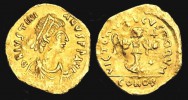
JUSTINIAN I, AU Tremissis, struck 527 - 565 at ConstantinopleObverse: D N IVSTINIANVS P P AVG, Pearl diademed, draped and cuirassed bust of Justinian facing right.
Reverse: VICTORIA AVGVSTORVM, Victory walking right, head facing left, holding laurel wreath in her right hand and globus cruciger in her left; star in right field; CONOB in exergue.
Diameter: 15mm | Weight: 1.34gms | Die Axis: 6
Slightly clipped
SBCV: 145 | DOC: 19*Alex
|
|
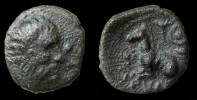
1st Century BC - 1st Century CE, IRON AGE BRITAIN, Tribe: Catuvellauni, AE Unit, Struck c.25BC – 10CE at Verlamion (St. Albans) under TasciovanusObverse: Bearded head facing right; VER anti-clockwise in front.
Reverse: Horse with sea horse tail facing left; pellet in ring, and trefoil motif above; VER below.
Diameter: 15.2mm | Weight: 1.97gms | Axis: 3h
SPINK: 243 | BMC 1714-21 | ABC 2658
RARE
CATUVELLAUNI
The Catuvellauni were an Iron Age Celtic tribe in Britain before the Roman conquest, attested by inscriptions into the 4th century. They are mentioned by Cassius Dio, who implies that they led the resistance against the conquest in 43CE. They appear as one of the “Civitates” of Roman Britain in Ptolemy's “Geography” in the 2nd century, occupying the town of Verlamion (Roman Verulamium, modern St.Albans) and the surrounding areas of Hertfordshire, Bedfordshire and southern Cambridgeshire. Their territory was bordered to the north by the Iceni and Corieltauvi, to the east by the Trinovantes, to the west by the Dobunni and to the south by the Atrebates, Regni and Cantii.
TASCIOVANUS
Tasciovanus appears to have become king of the Catuvellauni around 20 BC, before the Roman conquest of Britain. Ruling from Verlamion (St.Albans), for a brief period around 15–10 BC, he issued coins from Camulodunum (Colchester), apparently supplanting Addedomarus of the Trinovantes, but it appears that following the arrival of Augustus in Gaul he withdrew and again issued his coins from Verlamion.
Tasciovanus was the first Catuvellaunian king to issue inscribed coins, bearing “VER”, mint marks for Verlamion. He was also the first to renew hostilities towards the Trinovantes, flouting the long-standing agreement between Caesar and his own grandfather Cassivellaunus.
Tasciovanus died around AD 9 and was succeeded by his son Cunobelinus, who ruled primarily from Camulodunum.
CLICK ON MAP BELOW TO ENLARGE IT

*Alex
|
|

1st Century BC - 1st Century CE, IRON AGE BRITAIN, Tribe: Trinovantes, AE Unit, Struck c.10 BC – 10 CE in Camulodunum(?) in Essex under DubnovellaunusObverse: Head facing right, hair(?) lines on head divided by clear centre parting.
Reverse: Horse prancing left; complex pellets and circles above and below.
Diameter: 13.5mm | Weight: 1.61gms | Axis: 3h
SPINK: -- | BMC -- | ABC 2413
VERY RARE
Very rare uninscribed bronze unit of Dubnovellaunus found in Essex. The type is designated as a “Dubnovellaunus Centre Parting” bronze unit in ABC (Ancient British Coins), and to date (January, 2023) it is unlisted in any other major reference works.
DUBNOVELLAUNUS
It is generally thought that Dubnovellaunus succeeded his father Addedomarus as king of the Trinovantes somewhere around 10-5 BC and ruled for several years before being supplanted by Cunobelinus of the Catuvellauni.
In the Res Gestae Divi Augusti, a British king called Dumnovellaunus appears, alongside Tincomarus of the Atrebates, as a supplicant to Augustus in around AD 7 and, given the chronology, it is indeed possible that Dubnovellaunus of the Trinovantes is the same person as the Dumnovellaunus who presented himself to Augustus. The spelling variation is due to a Celtic, rather than a Latin, interpretation of the ruler's name.
It is worth mentioning that the authors of ABC (Ancient British Coins) also think that Dubnovellaunus of the Trinovantes could possibly be the same individual as the Dumnovellaunus who ruled in Kent in the 30s - 20s BC, they suggest that he could have been a Cantian king who later gained control over the southern part of the Trinovantes and that therefore he might have ruled both territories north and south of the Thames estuary for a few years. It should be noted however, that Van Arsdell, an authority on the Celtic Coinage of Britain, emphatically disputes this.
TRINOVANTES
The Trinovantes were one of the Iron Age Celtic tribes of Pre-Roman Britain. Their territory was on the north side of the Thames estuary in the present day counties of Essex, Hertfordshire and Suffolk, and also included lands now located in Greater London. They were bordered to the north by the Iceni, and to the west by the Catuvellauni. Their capital was Camulodunum (modern Colchester).
Shortly before Julius Caesar's invasion of Britain in 55 and 54 BC, the Trinovantes were considered the most powerful tribe in Britain. At this time their capital was probably at Braughing (in modern-day Hertfordshire). In some copies of Caesar's Gallic War their king is referred to as Imanuentius, although no name is given in other copies which have come down to us. That said however, it seems that this king was overthrown by Cassivellaunus, king of the Catuvellauni, some time before Caesar's second expedition and that Imanuentius' son, Mandubracius, fled to the protection of Caesar in Gaul. During his second expedition Caesar defeated Cassivellaunus and restored Mandubracius to the kingship. Cassivellaunus agreed to pay tribute and also undertook not to attack him again.
The next identifiable king of the Trinovantes, known from numismatic evidence, was Addedomarus, who took power around 20 – 15 BCE, and moved the tribe's capital to Camulodunum. For a brief period, around 10 BCE, Tasciovanus of the Catuvellauni issued coins from Camulodunum, suggesting that he must have conquered the Trinovantes, but he was soon forced to withdraw, perhaps as a result of pressure from the Romans. Addedomarus was restored and Tasciovanus' later coins no longer bear the mark “REX”. Addedomarus was briefly succeeded by his son Dubnovellaunus, around 10 to 5 BCE, but a few years later the tribe was conquered by either Tasciovanus or his son Cunobelinus.
The Trinovantes do not appear in history again until their participation in Boudica's revolt against the Romans in 60 CE. After that though they seem to have embraced the Romanisation of Britain and their name was later given to one of the “civitates” of Roman Britain, whose chief town was Caesaromagus (modern Chelmsford in Essex).
CLICK ON MAP BELOW TO ENLARGE IT

*Alex
|
|

1st Century CE, IRON AGE BRITAIN, Tribes: Catuvellauni and Trinovantes, AE Unit, Struck c.10 - 40 at Verlamion under CunobelinusObverse: CVNO - BELIN. Bare head facing left.
Reverse: TASCIO. Metal worker, wielding hammer, seated facing right.
Diameter: 15mm | Weight: 2.24gms | Axis: 3h
Spink: 342 | ABC: 2969 | Van Arsdell 2097
CUNOBELINUS
Cunobelinus was a king in Iron Age Britain from about 9 CE until about 40 CE. He is mentioned by the Roman historians Suetonius and Dio Cassius, and many coins bearing his inscription have been found. Cunobelinus controlled a substantial portion of south-eastern Britain, including the territories of the Catuvellauni and the Trinovantes, and is called “Britannorum rex" (King of the Britons) by Suetonius. He appears to have been recognized by the Roman emperor Augustus as a client king, shown by the use of the Latin title Rex on some of his coins.
Numismatic evidence appears to indicate that Cunobelinus took power around AD 9 after the death of his father Tasciovanus, minting coins from both Camulodunum, capital of the Trinovantes and Verlamion (Roman Verulamium), capital of the Catuvellauni. Some of the Verulamium coins name him as the son of Tasciovanus, a previous king of the Catuvellauni. Cunobelinus' earliest issues are, however, from Camulodunum, indicating that he took power there first, and some have a palm or laurel wreath design, a motif borrowed from the Romans indicating a military victory. It is possible that he was emboldened to act against the Trinovantes, whose independence was protected by a treaty they made with Julius Caesar in 54 BC, because problems in Germania severely affected Augustus' ability to defend allies in Britain.
Cunobelinus, however, appears to have maintained quite good relations with the Roman Empire, he used classical motifs on his coins and his reign also saw an increase in trade with the continent. Archaeological evidence shows an increase in imported luxury goods, including wine and drinking vessels from Italy, olive oil and “garum” (fish sauce) from Spain, as well as glassware, jewellery, and tableware from the wider continent, all of which, from their distribution, appear to have entered Britain via the port of Camulodunum. Rome's lucrative trade with Britain was also reported by Strabo, according to him the island's exports included grain, gold, silver, iron, hides, slaves and hunting dogs. It seems likely that Cunobelinus was one of the British kings, mentioned by Strabo, who sent embassies to Augustus.
Cunobelinus died about 40, probably within a year of that date, as he was certainly dead by 43.
Traditionally it has been suggested that the “Lexden Tumulus” on the outskirts of Colchester was Cunobelinus' tomb, but without evidence confirming that, it is also possible that the tomb was built for the earlier Trinovantian king, Addedomarus. Interestingly there is a second tumulus, though this one is not so well known, 665m to the northwest of the Lexden burial mound, on a grassy area in the middle of a modern housing estate. This tumulus, known as ‘The Mount’, probably dates from around the same time as the well-known one at Fitzwalter Road, Lexden.
CLICK ON MAP BELOW TO ENLARGE IT
 *Alex *Alex
|
|

Crispus, Siscia RIC 175AE 3 / 4 Crispus Votive
Obverse: IVL CRIS PVS NOBC, laureate head right.
Reverse: CAESARVMNOSTRORVM around VOT X ( I pledge 10 years)
TSIS in ex. Siscia mint, 16.5 mm,. 2.4 g.NORMAN K
|
|

"Boulogne" (VI) 17aConstantius I as Caesar 293-305 AD
AE Follis
Obv: FL VAL CONSTANTIVS NOB C
Laureate bust right
Rev: GENIO POPVLI ROMANI
Genius standing left
-/-//-
Uncertain continental mint (Boulogne?) operating around the time of the British invasion
RIC (VI) Lyon 17amauseus
|
|

1st Century CE, IRON AGE BRITAIN, Tribe: Atrebates, AR Unit, Struck c.25 -35 under EpaticcusObverse: EPATI. Head of Hercules, wearing lionskin headdress with paws tied before neck, facing right; pellet in ring behind.
Reverse: No legend. Eagle standing facing, head left, on serpent; dot in circle at upper right.
Diameter: 12mm | Weight: 1.1gms | Axis: 10 |
Spink: 356
Coin found in Hampshire, England. Old repair
EPATICCUS
Epaticcus was a son of Tasciovanus, and probably the younger brother of Cunobelin, he was also apparently a favoured uncle of Caratacus. It is from his coinage issues that we know his name and his family relationship.
The distribution of his coinage would indicate that Epaticcus expanded the territory of his tribe at the expense of the Atrebatean king Verica, and installed himself at the latter's capital, Calleva around 25 CE.
It is likely that Epaticcus was permitted to govern the area by his brother as part of the Catuvellaunian hegemony that was expanding across south eastern Britain at the time. Epaticcus continued to take Verica’s lands to west and south until his death, probably on campaign, around 35 CE. After this his expansionist policies were continued by his nephews, Caratacus and Togodumnus, into the late 30’s CE.
ATREBATES
The Atrebates were a Belgic Iron Age tribe originally dwelling in the Artois region of Northern France.
After the tribes of Gallia Belgic were defeated by Caesar in 57 BC, 4,000 Atrebates participated in the Battle of Alesia in 53, led by their chief Commius.
Before 54 BC, an offshoot of the Gallic tribe probably settled in Britain where it was successively ruled by kings Commius, Tincommius, Eppillus and Verica. Their territory comprised modern Hampshire, West Sussex and Berkshire, centred on the capital Calleva Atrebatum (modern Silchester). They were bordered to the north by the Dobunni and Catuvellauni; to the east by the Regni; and to the south by the Belgae.
The settlement of the Atrebates in Britain does not seem to have been a mass population movement and it is possible that the name "Atrebates", as with many "tribal" names in this period, referred only to the ruling house or dynasty and not to an ethnic group.
After the Roman conquest the Atrebates' lands were organized into the civitates of the Atrebates, Regni and possibly, the Belgae.
CLICK ON MAP BELOW TO ENLARGE IT

*Alex
|
|

Constantine II, RIC VII Rome 336Constantine II, AE follis, 18mm, 2.3 g. Rome.
Obverse: CONSTANTINVS IVN NOB C, laureate, draped & cuirassed bust right.
Reverse: GLOR-IA EXERCITVS, two soldiers standing, heads facing each other with two standards between them and each holds a spear and hand resting on a shield.
Mintmark RBS, Rome. 337-340 CE issueNORMAN K
|
|

Julian II RIC 100, Heraclea 355-360 CEObverse: DN IVLIA-NVS NOB C, bare-headed, cuirassed bust right.
Reverse: SPES REI-PVBLIC, emperor helmeted in military dress, standing left, holding globe and spear.
SMHD in ex. Heraclea mint. 17.4 mm., 1.8 g.NORMAN K
|
|

293 - 305, CONSTANTIUS I (Chlorus) as Caesar, AE Follis, struck 298 - 300 at Londinium (London), EnglandObverse: FL VAL CONSTANTIVS NOB C. Laureate and cuirassed bust of Constantius I facing right.
Reverse: GENIO POPVLI ROMANI. Genius, kalathos on head, standing facing left, holding patera in right hand and cornucopia in left; no mintmark (London).
Diameter: 28mm | Weight: 10.97gms | Die Axis: 6h
RIC VI: 14a | SRCV IV: 14034 | SPINK: 706
Rare
Ex Asprey Coins, London
Group II. Early example with the style of Constantius' portrait appearing to show the influence of Carausius/Allectus die engravers.*Alex
|
|

293 - 305, GALERIUS as Caesar, AE Follis struck 296 - 305 at Londinium (London), EnglandObverse: MAXIMIANVS NOBIL C. Laureate and cuirassed bust of Galerius facing right.
Reverse: GENIO POPVLI ROMANI. Genius, kalathos on head, standing facing left, holding patera in right hand and cornucopia in left; no mint-mark in exergue.
Diameter: 28mm | Weight: 9.4gms | Die Axis: 6h
RIC VI: 34 | SPINK: 710*Alex
|
|

293cfCrispus, Caesar 317-326 AD
AE Follis
Obv: CRISPVS NOB CAES
Laureate, cuirassed bust right
Rev: VIRTVS CAESS
Camp gate with open doors
TA crescent RL
Arelate Mint
LRBC I - (cf293-4)
RIC (VII) Arles -mauseus
|
|
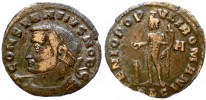
3 Constantius ICONSTANTIUS I
AE1 Folles, Lyons, Struck 301-301 AD
CONSTANTIVS NOB C, Laureate cuirassed bust l.., scepter over r. shoulder / GENIO POP-VLI ROMANI, Genuis standing left by altarholding patera and cornucopiae, A in l. field, PLG in ex.\\\\\\\\
RIC VI Lyons 167aSosius
|
|

3 Constantius ICONSTANTIUS I
AE light fraction, 295-299 AD
FL VAL CONSTANTIVS NOB CAES, RDC bust r, / CONCORDIA MI-LITVM, Emperor receiving Victory on globe from Jupiter, KB between, no mintmark
RIC VI Cyzicus 19A ScarceSosius
|
|

305 - 306, SEVERUS II as Caesar, AE Follis struck 305 - 306 at Londinium (London), EnglandObverse: SEVERVS NOBILISSIMVS CAES. Laureate and cuirassed bust of Severus II facing right.
Reverse: GENIO POPVLI ROMANI. Genius, kalathos on head, standing facing left, holding patera in right hand and cornucopia in left; no mint-mark in exergue.
Diameter: 29mm | Weight: 10.399gms | Die Axis: 6h
RIC VI: 59a | Cohen VII: 24 | SPINK: 712
Rare
Ex. Errett Bishop Collection | Ex. FORVM (USA)
SEVERUS II
Flavius Valerius Severus Augustus was a Western Roman Emperor from 306 to 307. He was born in Northern Illyria (now Albania) and rose to become a senior officer in the Roman army. As an old friend of Galerius, that emperor appointed Severus as Caesar on 1 May 305 and he thus served as junior emperor under Constantius I in the Western Roman Empire.
When Constantius I died in the summer of 306, Severus was promoted to Augustus by Galerius under the rules of succession established under the Tetrarchy. However Constantius I had died on campaign in York and his army in Britain had acclaimed his son, Constantine I, as his successor. Although furious at this elevation, Galerius wanted to avoid any threat of a civil war so he compromised by allowing Constantine to bear the title of Caesar.
When this news reached Maxentius, the son of Maximianus, he revolted and declared himself emperor at Rome,
Galerius sent Severus, at the head of an army which had previously been commanded by Maximianus, to suppress the rebellion. Maxentius asked his father to re-assume the purple and rule the empire with him and Maximianus, who had been reluctant to abdicate, readily accepted. When Severus arrived under the walls of Rome to besiege it his men deserted to their old commander forcing Severus to flee to Ravenna. Maximianus offered to spare his life and treat him humanely if he surrendered peaceably. Severus complied but, despite Maximianus' assurance, he was displayed as a captive, imprisoned and later put to death.
*Alex
|
|

317 - 326, CRISPUS as Caesar, AE3 struck 323 - 324 at Londinium (London), EnglandObverse: CRISPVS NOBIL C. Helmeted and cuirassed bust of Crispus facing left.
Reverse: BEAT TRANQLITAS (sic). Altar, inscribed VOT IS XX in three lines, surmounted by cosmic globe with three stars above; in exergue, PLON.
Diameter: 20mm | Weight: 2.8gms | Die Axis: 6h
RIC VII : 275.
Flavius Julius Crispus was the eldest son of Constantine the Great, he was given the rank of Caesar in A.D.316, at the same time as Flavius Claudius Constantinus (Constantine II), Constantine's eldest son with Fausta, and Valerius Licinianus Licinius (Licinius II), the son of Licinius I.
This coin was struck in connection with the fifteenth anniversary of Constantine the Great.*Alex
|
|

317 - 337, CONSTANTINE II as CAESAR, AE3 struck 324 - 325 at Londinium (London), EnglandObverse: CONSTANTINVS IVN NOB C. Diademed, draped and cuirassed bust of Constantine II, viewed from the rear, facing right.
Reverse: PROVIDENTIAE CAESS. Camp-gate with two turrets, star above; in exergue, PLON.
Diameter: 20mm | Weight: 3.43gms | Die Axis: 6h
RIC VII : 296 | SPINK: 738a*Alex
|
|

324 - 337, CONSTANTIUS II as CAESAR, AE3 struck 324 - 325 at Londinium (London), EnglandObverse: FL IVL CONSTANTIVS NOB C. Laureate, draped and cuirassed bust of Constantius II facing left.
Reverse: PROVIDENTIAE CAESS. Camp-gate with two turrets, star above; in exergue, PLON.
Diameter: 19mm | Weight: 2.85gms | Die Axis: 6h
RIC VII : 298 | SPINK: 739
Rare
*Alex
|
|

4 GaleriusGALERIUS
AE Follis, Antioch, 299-300 A.D.
GAL VAL MAXIMIANVS NOB CAES, bust l. / GENIO POPV-LI ROMANI, Genius standing left left, holding patera and cornucopia, epsilon in r. filed, ANT in ex
RIC VI Antioch 53b Sosius
|
|

4 GaleriusGALERIUS
Silvered Follis, Heraclea, 297-298 AD
GAL VAL MAXIMIANVS NOB CAES, head l. / GENIO POPV-L-I ROMANI, Genius standing l., holding patera and cornucopiae, HT epsilon in ex.
RIC VI Heraclea 20bSosius
|
|
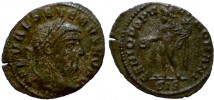
5 Severus IISEVERUS II
AE Quarter-Folles , Siscia, 305-306 AD
FL VAL SEVERVS NOB C, Bust r. / GENIO POP-VLI ROMANI, Genius standing left holding patera and cornucopiae, SIS in ex
RIC VI Siscia 170a Rare Sosius
|
|

5 Severus IISEVERUS II
AE Quarter-Folles, Siscia, 305-306 AD
O: SEVERVS NOB C, Laureate bust left / GENIO POP-VLI ROMANI, Genius, naked, wearing modius, holding patera and cornucopia, chalmys over l. shoulder
RIC VI Siscia 171a; Rare; Fine, rough. Sosius
|
|

6 Maximinus IIMAXIMINUS II
AE Follis, Nicomedia, 307-308 AD
GAL VAL MAXIMINVS NOB CAES, bust l. / GENIO CA-ESARIS CM[H], Genius with patera and cornucopia, SMN gamma in ex.
RIC VI Nicomedia 55 Sosius
|
|

6.5 Valerian IIVALERIAN II
BI Antoninianus, 256 - 8 A.D.
Antioch or Samosata mint
O: VALERIANVS NOBIL CAES, Radiate, draped & cuirassed bust r.
R: PRINC IVVENTVTIS, Valerian, shield on ground and spear in left hand, crowning trophy of arms with r. hand
RIC V 49, RSC IV 67
Sosius
|
|

6.5 Valerian IIVALERIAN II
AR Antoninianus, Rome Mint
254-255 AD
P C L VALERIANVS NOB CAES, Radiate draped bust r. / PIETAS AVGG, Sacrificial implements, including, lituus, knife, fluted jug turned left, simpulum and aspergillum
RIC V-1, 20; Cohen 56Sosius
|
|

73 Constantius II, Arles RIC VII 342v (added to wildwinds)Constantius II
AE18, 2.2g, Arles. 330-348 AD.
FL IVL CONSTANTIVS NOB C, laureate, draped, cuirassed bust right / GLOR-IA EXERC-ITVS, two soldiers holding spears and shields, standing left and right of two standards with thin poles and small badges. Star between standards. Mintmark SCONST.
RIC VII Arles 347v. Sear (2014) 17676 EF, irregular flan
Note: Coin unique due to star placement. Added to Wildwinds in May 2011Sosius
|
|

8 CarinusCARINUS
BI Antoninianus. Rome mint, 282 AD
M AVR CARINVS NOB C, Radiate, draped, cuirassed bust r. / PIETAS AVGG, sacrificial implements (sprinkler, simpulum, jug, patera, knife and lituus), KAZ in ex.
RIC 157c. gVF. Ex Othilla Coins
Sosius
|
|
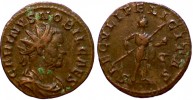
8 CarinusCARINUS
BI Antoninianus. Lugdunum mint, 282 AD
CARINVS NOBIL CAES Radiate, draped and cuirassed bust right / SAECVLI FELICITAS Carinus standing right with globe and spear. Retrograde D in r. field
RIC 152c. aVF. Ex Othilla Coins
Sosius
|
|

8.5 Licinius IILICINIUS II
AE Follis, Cyzicus Mint, 317-320 AD
DN VAL LICIN LICINIVS NOB C, Laureate, draped bust l., holding sceptre in left hand, mappa in right hand / IOVI CONSER-VATORI CAESS, Jupiter standing left, holding Victory on globe and sceptre, wreath in l. field, B in r. field, SMK in ex.
RIC VII Cyzicus 11, VF. R3.Sosius
|
|

98 Zeno SolidusZeno, First Reign
AV Solidus. Constantinople Mint
D N ZENO-PERP AVG, facing helmeted and cuirassed bust, holding shield, spear behind / VICTORI-A AVGGG and officina letter, Victory standing left, holding long cross, star in right field, CONOB in exergue.
RIC 910. Sear (2014) 21514. Broad flan. Holed, but otherwise VF.
Thanks to FORVM member Rick2 for his help identifying this coin!Sosius
|
|

Celtic CoinageContinental Celts & Tribes of Britannia
Gaul: Northwest Gaul: Aulerci Eburovices, Carnutes, Coriosolites, Redones, Senones, Veneti. Northeast Gaul: Ambiani, Remi, Suessiones (Cricironus), Treveri.
Central Gaul: Aediu, Arverni. Sequani (Turonos & Cantorix). Southern Gaul: Massalia (Marseilles), Tolostates, Volcae-Arecomici. Uncertain: Volcae Tectosages, Leuci, Senones.
Britain: Atrebates & Regni (Verica), Cantii (Amminus), CantuvellauniCorieltauvi (Volisios Dumnocoveros), Cunobelin, Dobunni, Durotriges, Epaticcus, Iceni, Trinovantes, Cantuvellauni & Trinovantes (Addedomaros, Caratacus).
Lower Danube: Geto-Dacians. Middle Danube: Hercuniates. Central Europe: Boii. Danubian Celts are also referred to as being from the Carpathian Region, in which there were various tribes, many unknown. Anaximander
|
|

CONCORDIA MILITVM, Thessalonica; RIC VIII 167Constantius Gallus, Caesar, AE Centenionalis. Thessalonica Mint, 23mm; FL IVL CONSTANTIVS NOB CAES, bare-headed & cuirassed bust right / CONCORDIA MILITVM, Gallus standing facing, head left, holding two labara, each bearing a Chi-Rho; G-//*TSE*. LRBC 1667. Thessalonica. RIC VIII 167.Podiceps
|
|
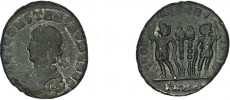
Constans, RIC VIII 141 HeracleaConstans, AE 3, 333-336 CE.
Obverse: FLI CONSTANS NOB CAES, laureate, draped, cuirassed bust left.
Reverse: GLORIA EXERCITVS, two soldiers facing each other holding spears and shields with two standards between them.
SMHE in ex. Heraclea mint, 17.7mm, 2.4 g.NORMAN K
|
|

Constantine II, AE3, Thessalonica, RIC VII, 157, 326-328 CE
Constantine II, AE3, 326-328, Thessalonica, Officina 4
Obverse: CONSTANTINVS IVN NOB C, Laureate, draped, cuirassed bust left
Reverse: PROVIDEN_TIAE CAESS, Campgate with six rows, two turrets, no doors, star above, top and bottom rows empty blocks
SMTSD in exergue
19.5mm, 2.7g
RIC VII, 157 nearly full silveringNORMAN K
|
|

Constantine II, RIC 381 var. TrierConstantine II, AE19, Trier. 322-323 CE
Obverse: CONSTANTINVS IVN NOB C, laureate and cuirassed bust right, holding spear over shoulder and horse by the bridle before.
Reverse: BEATA TRAN-QVILLITAS, large globe on an altar inscribed V dot O - TIS - XX in three lines, three stars above.
Mintmark: PTR dot., RIC VII Trier 381 var (mintmark) 18.9 mm, 2.7 g.
NORMAN K
|
|

Constantine II, RIC VII 199 ThessalonicaConstantine II, AE follis, 18.6 mm, 1.8 g. Thessalonica.
Obverse: CONSTANTINVS IVN NOB C, laureate, draped & cuirassed bust right.
Reverse: GLOR-IA EXERCITVS, two soldiers standing, heads facing each other with two standards between them and each holds a spear and hand resting on a shield.
Mintmark SMTSB Thessalonica. 337-340 CE.
NORMAN K
|
|

Constantine II, RIC VII Siscia 236Constantine II, AE follis, 18mm, 1.8 g. Siscia.
Obverse: CONSTANTINVS IVN NOB C, laureate, draped & cuirassed bust right.
Reverse: GLOR-IA EXERCITVS, two soldiers standing, heads facing each other with two standards between them and each holds a spear and hand resting on a shield.
Mintmark dot ESIS dot, 334-335 CE issueNORMAN K
|
|

Constantine II, RIC VII, 128 Thessalonica
Constantine II, AE3, 324, Thessalonica, Officina 2
Obverse: CONSTANTINVS IVN NOB C, Laureate, draped, cuirassed bust left
Reverse: CAESARVM NOSTRORVM , Legend surrounding laurel wreath terminating in large jewel enclosing VOT / . / X
TSBVI in exergue ThessalonicaNORMAN K
|
|

Constantine II, Siscia RIC VII 220Constantine II, 334-335 C.E., AE3
Obverse : CONSTANTINVS IVN NOB C. Laureate bust right, cuirassed
Reverse : GLOR-IA EXERCITVS-ITVS. Two soldiers facing and holding a spear two standards between them.
ESIS in ex. Siscia 18.7 mm., 1.7 g. RIC VII, 220 p. 453NORMAN K
|
|

Constantius Gallus, Sirimun RIC 53Constantius Gallus AE3
Obverse: DN CONSTANTIVS IVN NOB C, bare-headed, draped, cuirassed bust right.
Reverse: FEL TEMP RE-PARATIO, soldier spearing fallen horseman who is bare-headed, bearded, reaching backwards.
Mintmark dot BSIRM dot, 18.4 mm, 2.2 g.NORMAN K
|
|

CONSTANTIUS I CHLORUS, FOLLIS RIC 30a Aquilia, 300 CE Obverse: CONSTANTIVS NOB CAES, Laureate head right.
Reverse: SACRA MONET AVGG ET CAESS NOSTR, Monet standing left holding scales and cornucopia.
AQT in ex., 27.92mm., 9.4 g, NORMAN K
|
|

Constantius II RIC VII Rome 329
Constantius II
AE 16mm, 2.0g, 330 AD
OBV :: FL IVL CONSTANTIVS NOB C; Laureate, draped and cuirassed bust right
REV :: GLOR-IA EXERC-ITVS; 2 soldiers standing either side of 2 standards
EX :: RFT
REF ::RIC VII Rome 329; Sear 17684
From uncleaned lot 2019Johnny
|
|
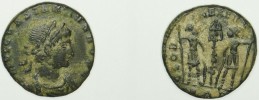
Constantius II, RIC VII 145, Aquileia, 337-361 CEObverse: FL IVL CONSTANTIVS NOB C, laureate, draped, cuirassed bust right.
Reverse:GLOR-IA EXERC-ITVS, two soldiers holding spears and shields with one standard between them.
Mintmark: dot AQP, Aquileia 15.5 mm., 1.6 g.
RIC VII Aquileia 145NORMAN K
|
|

Crispus AE follis. 324-325 AD.Sirmium RIC VII 49
Crispus AE follis.. 324-325 AD. FL IVL CRISPVS NOB CAES, laureate head right / ALEMANNIA DEVICTA, Victory advancing right, holding trophy and palm, treading upon bound captive on right. Mintmark dot SIRM dot. Cohen 1. Britanikus
|
|

Crispus RIC VII 69 Thessalonica, 319 CEObverse: IVL CRIS-PVS NOB C, laureate and cuirassed bust right.
Reverse: VIRT EXERC, Sol raising right hand and holding globe in left, standing in center of plan of roman camp.
TS dot E dot in ex. Thessalonica mint
19.53mm., 2.2g. rare
The true meaning of this reverse type has never been fully deciphered. The latest theory being the X shaped pattern represents Constantine's vision before the battle of Milvainbridge. This does not seem likely since the type is known on coins of Licinius a pagan and Constantine's enemy
sold 4-2018
NORMAN K
|
|

Crispus, son of Constantine, Caesar 317-326 AD. Trier
Crispus AE3. 317-326 AD. IVL CRISPVS NOB CAES, laureate, cuirassed bust left, holding spear & shield / BEATA TRANQVILLITAS, globe on altar inscribed VOT/IS/XX, 3 stars above, STR in ex. RIC VII 308,S Antonivs Protti
|
|

Delmatius, Cyzicus RIC 132Obverse: FL IVL DELMATIVS NOB C, laureate, cuirassed bust right.
Reverse: GLORIA EXERCITVS, two helmeted soldiers facing each other, spear in outer hand, inner hand on shield setting on ground, between them a standard.
SMKD in ex. Cyzicus mint15.4 mm,1.8 g. Rated R3NORMAN K
|
|

Galerius GENIO POPVLI ROMANI from London… Ex-Rauceby HoardGalerius
A.D. 303- 305
Æ follis 28mm 10.2g
MAXIMIANVS NOB CAES; laureate, draped and cuirassed bust right.
GENIO POPVLI ROMANI; Genius standing left, modius on head, naked but for chlamys over left shoulder, right holding patera, left cornucopiae.
No mintmark
RIC VI London 36; LMCC 3.01.034
Ex-Rauceby Hoard
This hoard was discovered in the UK in 2017 and totaled 3,099 coins. Two coins were radiates (before A.D. 282) and the rest were struck from A.D. 294- 307. The majority are from western mints…London (875) Trier (1459) and Lyon (468).
Victor C
|
|

Galerius Maximian RIC 16b, HeracleaGalerius, AE radiate fraction, Heraclea, 295-296 CE.
Obverse: GAL VAL MAXIMIANVS NOB CAES, radiate, draped & cuirassed bust right
Reverse: CONCORDIA MIL ITVM, Emperor, standing right, receiving victory on globe from Jupiter who is standing left, holding scepter. H gamma in lower center
Heracles mint 21 mm., 2.3 g.NORMAN K
|
|
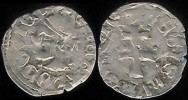
Huszár 547, Pohl 89-7, Unger 432h, Réthy II 89ALouis I (Lajos I, in Hun.) (1342-1382). AR denar, .49 g., 13.94 mm. max., .28 gr., 90°
Obv: + [MO]nETA LODOVICI, Saracen head left, pellets flanking.
Rev: + REGIS hVnGARIE, Patriarchal cross with random pellets.
The type was struck 1373-1382 (per Huszár, Pohl & Unger, although Huszár later wrote that the Saracen-head coinage incepted in 1372). This privy mark was struck at Pécs by one of the Saracenus brothers, probably by Johannes, who took over the mint after the death of Jacobus (per Pohl).
Huszár/Pohl rarity rating 3.
The Saracen's head is a pun on the surname of Jacobus Saracenus (Szerechen, in Hun.) and his brother, Johannes, courtiers of Italian descent who were ennobled by Louis. The image of a Saracen's head appeared on their coat of arms. Jacobus became the kammergraf at the Pécs mint in 1352, and the Comes Camerarum Regalium in 1369. He died in the early 1370s, at which time Johannes succeeded him as kammergraf.Stkp
|
|

Julian II RIC 370 Siscia, 355-360 CEObverse: DN IVLIANVS NOB CAES, bare-headed, draped and cuirassed bust right.
Reverse: FEL TEMP-REPARATIO, soldier standing left, spearing fallen horseman who is wearing Phrygian helmet, reaching backwards, M to left, DSIS-Zigzag in ex
RIC VIII Siscia 370, 16.9 mm., 2.2 g.NORMAN K
|
|

Julian II, RIC VIII 376 SisciaJulian II "the Apostate," February 360 - 26 June 363 A.D.
Bronze AE 3, as Caesar 355 - 361 A.D.; Obverse: D N IVLIANVS NOB CAES, cuirassed bust right
Reverse FEL TEMP REPARATIO, soldier spearing fallen horseman, M in left field, pellet in right.
ΔSISD in ex.,RIC VIII 376 Siscia mint, 2.2g, 16.9mm, scarceNORMAN K
|
|

Licinius II RIC VII Rome 154 Licinius II
AE 20-22 mm 3.1 grams
OBV :: LICINIVS IVN NOB C. Laureate, draped and cuirassed bust right
REV :: ROMAE A-ETERNAE. Roma seated right holding shield on lap inscribed with XV. P in left , R in right fields.
EX :: R ? ( Rome )
REF :: RIC VII Rome 154
from uncleaned lot 02/2009
Coin is bouble struck as is seen above the bust. Also has " clogged die " error at the IVN part of the obverse legend making the text appear as CIN Johnny
|
|

Licinius II VOT V Siscia Licinius II VOT V Siscia
Licinius II LICINIVS-IVN NOB C L
CAESARVM NOSTRORVM VOT V
dot in badge at top of wreath delta SIS star
Siscia RIC VII Siscia 162 s
usually 18-19 mm 320-321 ADJames b4
|
|

Maximinus II RIC 171B SisciaMaximinus II quarter follis, 305-306 CE
Obverse: MAXIMINVS NOBC, laureate bust right.
Reverse: GENIO POP_VLI ROMANI , Genius standing left, modius on headn naked but for chlamys over shoulder, holding patera and cornucopia.
SIS in ex. Siscia mint. 19.1 mm., 2.0 g.NORMAN K
|
|

Maximinus II, as Caesar, 305-309. AE Follis. 27mm // 7,36g. Heraclea, 305-306.Obv.GAL VAL MAXIMINVS NOB CAES Laureate head of Maximinus II to right.
Rev. GENIO CAESARIS/ HTD Genius, nude but for chlamys over his left shoulder, standing front, head to left, holding patera, from which liquor flows, in his right hand and a cornucopiae with his leftCanaan
|
|

Severus II GENIO POPVLI ROMANI from London… Ex-Rauceby HoardSeverus II
A.D. 305- 306
Æ follis 28mm 8.6g
SEVERVS NOBILIS C; laureate, draped and cuirassed bust right.
GENIO POPVLI ROMANI; Genius standing left, modius on head, naked but for chlamys over left shoulder, right holding patera, left cornucopiae.
No mintmark
RIC VI London 63a; LMCC 4.02.019
This hoard was discovered in the UK in 2017 and totaled 3,099 coins. Two coins were radiates (before A.D. 282) and the rest were struck from A.D. 294- 307. The majority are from western mints…London (875) Trier (1459) and Lyon (468).
Victor C
|
|

RIC.289 Constantine II (AE3, Providentiae Caess)Constantine II, caesar (317-337), western emperor (337-340)
AE3 : Providentiae Caess (326, Rome mint)
bronze, 18mm diameter, 2.80 g, die axis: 6h
A/ CONSTANTINVS IVN NOB C; pearl-diademed, draped and cuirassed bust right
R/ PROVIDEN-TIAE CAESS / R(wreath)T in exergue; open camp gate, two turrets, no door and a star above
|
|

RIC.322 Constantine II (AE3, Virtvs Caess)Constantine II, caesar (317-337), western emperor (337-340)
AE3 : Providentiae Caess (328-329, Arles mint, 3rd officine)
bronze, 19mm diameter, 3.14 g, die axis: 12h
A/ CONSTANTINVS IVN NOB C; pearl-diademed, draped and cuirassed bust right
R/ VIRTVS - CAESS / TCONST in exergue, S | F in the field; gateway wide wide open doors, four turrets and a star above
|
|

D.163 Eudes (denier, Blois)Eudes, king of the Franks (888-898)
Denier (Blois)
Silver, 1.59 g, 20 mm diameter, die axis 3h
O/ +MISERICORDIΛ DE-I; monogram
R/ +BIESIΛNIS CΛSTRâ—Š; cross pattée
Eudes was not a Carolingian. As count of Paris, he obtained successful results against the Viking attacks. He was then chosen by frankish noblemen to be the king. The legitimate heir Charles III the Simple was then too young to rule.
This type of coinage is a very Carolingian one.
Eudes made his own monograms. This one is quite elaborate, with â—ŠDO above and RX below. Still on the obverse, the inscription is Misericordia Dei instead of the traditional Gratia Dei Rex. These two features (monogram and legend) make this coin very similar to Louis III's coins of Touraine (Blois and Tours mainly).
|
|

D.774 Rudolph (denier, Paris)Rudolph (or Raoul, Radulf), king of the Franks (923-936)
Denier (Paris)
Silver, 1.13 g, 18 mm diameter, die axis 11h
O/ +CRATIA DI REX; monogram
R/ + / PΛRISI / CIVITΛ / +
Rudolph was elected king of Franks by noblemen in 923, after his father-in-law (Robert I)'s death.
Although Rudolph wasn't a carolingian, his coinage used a monogram.This monogram is clearly inspired by the habitual KRLS monogram. The letters seem to be R(?)DFS. Anyway, the F on the bottom can be cleary distinguished, and this coin can be attributed to Rudolph.
|
|

"Boulogne" (VI) 17bGalerius as Caesar
AE Follis
Obv: C VAL MAXIMIANVS NOB C
Laureate bust right
Rev: GENIO POPVLI ROMANI
Genius standing left
-/-//-
Uncertain continental mint (Boulogne?) operating around the time of the British invasion
RIC (VI) Lyon 17bmauseus
|
|

(0218) Elagabalus218 - 222 AD
AE 25mm 11.92g
O: Laureate head right
R: Eagle standing facing, open wings, head turned left, holding wreath in beak;
Nikopolis ad Istrum, Moesia Inferior; under Governor Nobius Rufus
cf AMNG 1993laney
|
|
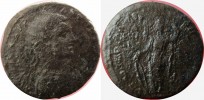
(0218) ELAGABALUS218 - 222 AD
AE 25 mm 9.62 g
O: AV(T?) KM AVR - ANTWNINOC, cuirassed, radiate bust r.
R: VP NOBIOV ROVFOV NIKOPOLITWN PRO (PR ligate) in l. field one below the other C ITRO / N (sic!), Athena stg. l., holding spear in raised l. hand and shield set on ground in r. hand
Nikopolis ad Istrum
AMNG I/1, 1920 (1 ex., Paris); Hristova/Jekov No. 8.26.4.5 corr. laney
|
|

(0218) ELAGABALUS218 - 222 AD
AE Assaria 27 mm 13.59 g
Obv: [AVT K M AVPH] ANTWNEINOC K, laureate head right
Rev: VP NOBIOV POVFOV NIKOPOLITWN PROC IC-TPO-N, Fortune standing, holding
rudder on globe in right hand and cornucopiae in left
Nikopolis ad Istrum
Moushmov 1451
laney
|
|
| 4872 files on 55 page(s) |
1 |
 |
 |
 |
 |
|

|
